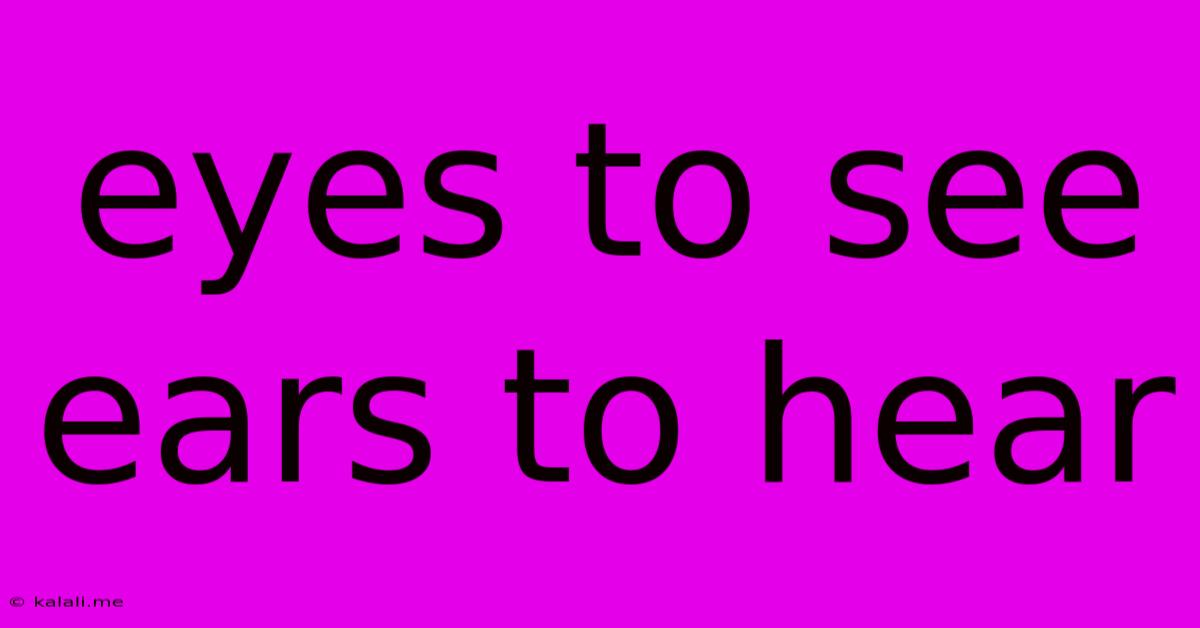Eyes To See Ears To Hear
Kalali
May 24, 2025 · 3 min read

Table of Contents
Eyes to See, Ears to Hear: The Power of Sensory Integration and its Impact on Our Lives
Meta Description: Explore the fascinating world of sensory integration – how our eyes and ears work together, the impact of sensory processing issues, and strategies for improving sensory experiences. Discover how vital this interconnectedness is for learning, development, and overall well-being.
Our world is a symphony of sights and sounds, a constant barrage of sensory input that shapes our understanding and experience. From the vibrant hues of a sunset to the gentle melody of rain, our senses – particularly our eyes and ears – work in intricate harmony to build our perception of reality. This article delves into the fascinating world of sensory integration, focusing on the interplay between sight and sound and their impact on our lives.
The Interconnectedness of Sight and Sound
The human brain is a masterful orchestrator, constantly processing information from multiple senses simultaneously. While we often think of sight and sound as separate entities, they are deeply intertwined. Consider watching a movie: the visual narrative is enhanced exponentially by the accompanying soundtrack, creating a richer, more immersive experience. Similarly, listening to a piece of music often evokes vivid mental images, demonstrating the seamless collaboration between our auditory and visual systems.
This interconnectedness is crucial for several reasons:
- Enhanced Perception: Our brains combine visual and auditory information to create a more complete and accurate understanding of our environment. For example, locating a sound source relies heavily on both visual cues (seeing the source) and auditory cues (hearing the sound).
- Improved Communication: Nonverbal cues, such as facial expressions and body language, significantly enhance the comprehension of spoken language. Watching someone speak allows us to interpret their tone, emotion, and intent, leading to more effective communication.
- Cognitive Development: Early childhood development is significantly impacted by sensory integration. Infants learn to associate sounds with visual stimuli, laying the foundation for language acquisition and cognitive growth. Exposure to diverse sounds and sights stimulates brain development and enhances learning capabilities.
Sensory Processing Issues: When Sight and Sound Don't Sync
Sometimes, the intricate dance between our senses falters. Sensory processing issues, or sensory integration dysfunction, can manifest in various ways, impacting how individuals perceive and respond to sensory input. For instance, individuals with auditory processing disorders may struggle to filter out background noise, leading to difficulties in understanding speech or concentrating. Similarly, visual processing difficulties can impact reading comprehension, spatial awareness, and visual-motor skills.
These challenges can significantly affect daily life, impacting learning, social interaction, and overall well-being. Early identification and appropriate intervention are crucial in mitigating these difficulties and supporting optimal development.
Strategies for Enhancing Sensory Experiences
We can all benefit from strategies that enhance the integration of our senses:
- Mindful Observation: Actively engaging our senses can improve sensory integration. Take the time to truly observe your surroundings, paying close attention to both visual details and sounds.
- Sensory Activities: Engaging in activities that stimulate multiple senses can be incredibly beneficial. Think about listening to music while reading a book, or watching a nature documentary with accompanying soundscapes.
- Creating a Sensory-Friendly Environment: Minimizing distractions and creating a calm and organized space can help reduce sensory overload and improve focus.
In conclusion, the interplay between our eyes and ears is far more complex and significant than we often realize. Understanding this interconnectedness, as well as the potential challenges of sensory processing issues, allows us to appreciate the power of our sensory systems and develop strategies for optimizing our sensory experiences. By fostering a richer engagement with our sensory world, we can enhance learning, communication, and overall well-being.
Latest Posts
Latest Posts
-
Ora 03113 End Of File On Communication Channel
May 24, 2025
-
How To Remove Broken Tub Drain
May 24, 2025
-
How To Write And Or In A Sentence
May 24, 2025
-
How To Calculate P Value For Categorical Data
May 24, 2025
-
Where Does Dogmeat Go In Sanctuary
May 24, 2025
Related Post
Thank you for visiting our website which covers about Eyes To See Ears To Hear . We hope the information provided has been useful to you. Feel free to contact us if you have any questions or need further assistance. See you next time and don't miss to bookmark.